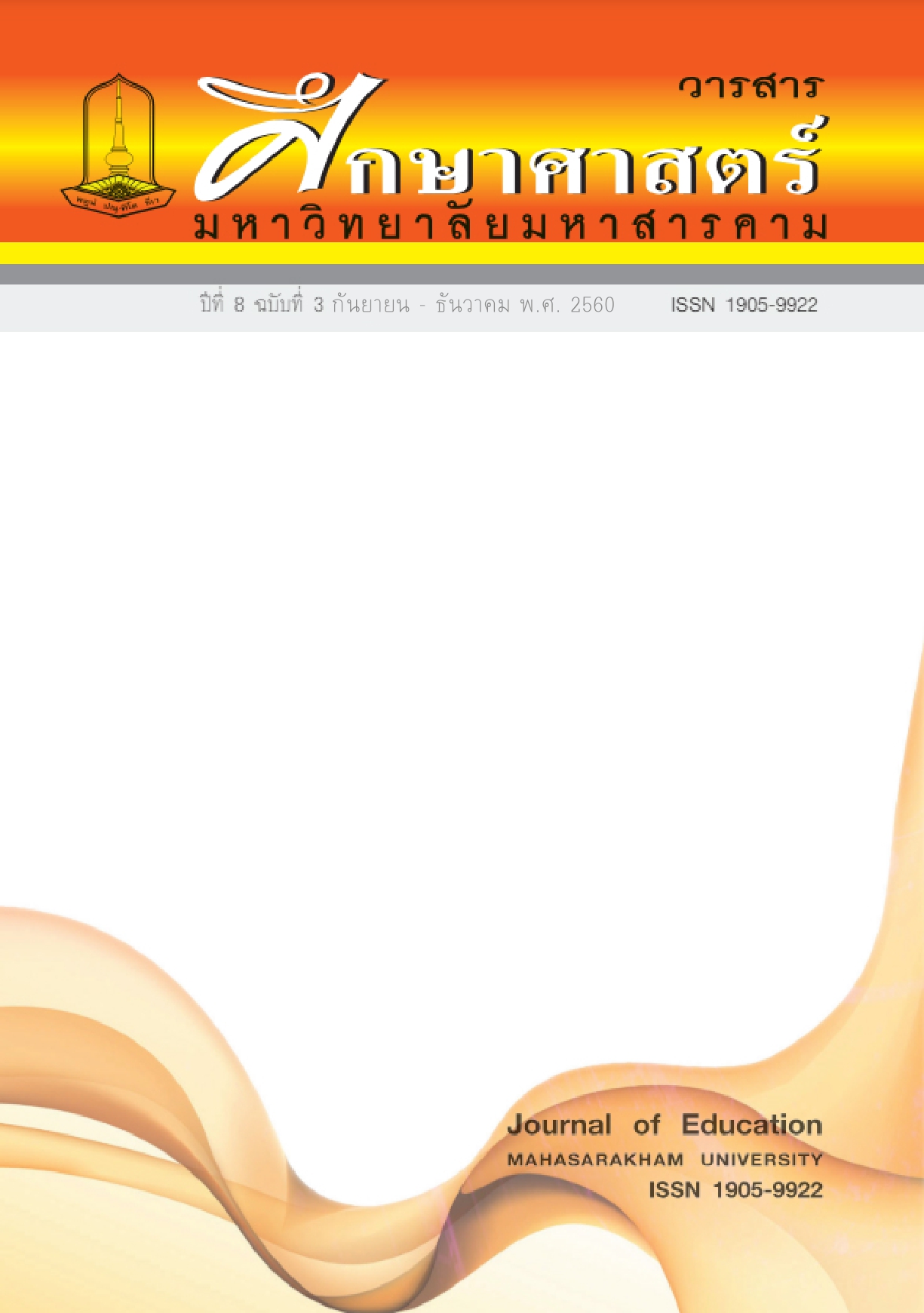ผลของการฝึกแบบสลับช่วงเวลาพักที่มีต่อสมรรถภาพทางแอนแอโรบิกความอดทนและความเร็วในนักเรียนชาย
Main Article Content
บทคัดย่อ
การวิจัยครั้งนี้ เพื่อเปรียบสมรรถภาพทางแอนแอโรบิก ความอดทนและความเร็วในนักวิ่งระยะสั้นที่ใช้ช่วงเวลาพักที่แตกต่างกัน ก่อนการฝึกระหว่างฝึกและหลังการฝึก กลุ่มตัวอย่างคือ นักวิ่งระยะสั้นชายที่มีอายุระหว่าง 17-19 ปี กำลังศึกษาระดับชั้นมัธยมศึกษาตอนปลาย โรงเรียนประโคนชัยพิทยาคม จำนวน 30 คน คัดเลือกโดยวิธีการเลือกกลุ่มตัวอย่างแบบง่าย แบ่งกลุ่มทดลองเป็น 3 กลุ่มๆละ 10 คน ทั้ง 3 กลุ่ม ฝึกด้วยโปรแกรมการฝึกแบบสลับช่วงเวลาพัก ที่ความหนักที่ 80-90 % MHR. วิ่งระยะทาง 50 เมตรจำนวน 8 เที่ยว ช่วงเวลาพักแต่ละกลุ่ม ที่ 30 60 และ 90 วินาที โดยทำการฝึกใน วันจันทร์ พุธ และศุกร์ เป็นระยะเวลา 8 สัปดาห์ นำผลมาวิเคราะห์ข้อทางสถิติโดยหาค่าเฉลี่ย (Mean) และส่วนเบี่ยงเบนมาตรฐาน (S.D.) เปรียบเทียบความแตกต่างของกลุ่มตัวอย่างทั้ง 3 กลุ่ม โดยการวิเคราะห์ความแปรปรวนแบบสองทาง ที่ระดับนัยสำคัญทางสถิติที่ 0.05 หากพบความแตกต่างจึงทำการเปรียบเทียบความแตกต่างเป็นรายคู่ โดยใช้วิธีของ Bonferroni
ผลการวิจัย พบว่า หลังการฝึก กลุ่มทดลองที่ฝึกด้วยโปรแกรมการฝึกแบบสลับช่วงเวลาพักวิ่งที่ความหนัก 80-90 % MHR.วิ่งที่ระยะทาง 50 เมตร จำนวน 8 เที่ยว ช่วงเวลาพักแต่ละเที่ยว 60 วินาที พบว่า สมรรถภาพทางแอนแอโรบิกค่ากำลังสูงสุด มีค่าเฉลี่ยสูงกว่าก่อนการฝึก มากที่สุด อย่างมีนัยสำคัญทางสถิติที่ระดับ 0.05
สรุปผลการวิจัย กลุ่มทดลองที่ใช้ช่วงเวลาพักแต่ละเที่ยว 60 วินาที พบว่า สมรรถภาพทางแอนแอโรบิกค่ากำลังสูงสุด มีค่าเฉลี่ยสูงกว่าก่อนการฝึกอย่างมีนัยสำคัญทางสถิติที่ 0.05
Downloads
Article Details
เอกสารอ้างอิง
American Academy of Orthopedic Surgeons. (1991). Athletic Training and Sport medicine. 2nd ed. Chicago: Lippincott Williams and Wilkins.
Astrand, P. O., & Rodahl, K. (2005). Textbook of Work Physiology Physiological Bases of Exercise. Singapore: McGraw – Hill.
Bell, G. J. et al. (1989). The effect of velocity-specific strength training on peak torque and Anaerobic Rowing Power. Journal of Sport Science, 33, 205 - 214. Abstract from: (CD- ROM). Sport Discus: Anaerobic Power Item: 53.
Ellick, A. (2001). Running Times Magazine. Retrieved November 17, 2010, from http://running times.com/Article.asp? ArticleID=551
Foster, C., Poole, C., Bushey, B., & Wilborn, C. (2009). Comparison of aerobic training Methods on VO2max, body composition and anaerobic power. Medicine & Science in Sports & Exercise, 41(5), 501. Retrieved February 27, 2010, from www.acsm.org
Hall, S.J. (1999). Basic Biomechanics 3rd Edition. McGaw-Hill, Singapore.
Hay, J.G. (1993). The Biomechanics of Sport Techniques 4th Edition. Prentice Hall Limited, USA
Hetlelid, K., Herold, E., & Seiler, S. (2009). Comparison of metabolic responses tohigh- Intensity interval training in trainined and well-trained males. Medicine & Science in Sports.
King, J., Broeder, C., Browder, K., & Panton, L. (2003). A comparison of interval versussteadystate exercise on substrate utilization in overweight women.
McArdle, D. W., Katch, I. F., & Katch, L. V. (2010). Exercise Physiology: Nutrition, Energy, and Human Performance (7th Ed.) Baltimore: Lippincott Williams & Wilkins.
Medbø, J. I., & Burgers, S. (1990). Effect of training on the anaerobic capacity. Medicine and science in sports and exercise, 22(4), 501.
Moungmee.P. (2548). Underlying physiology of exercise. 1st edition. Bangkok: Burapasarn.
Moss, C. L., & Grimmer, S. (2003). Strength and contractile adaptations in the human triceps surae after isotonic exercise. Journal of Sport Rehabilitation, 29, 104-114
Rainer, M. (2004). Successful Coaching. 3rd ed. Champaign: Human Kinetics Publishers. Sutham, T. and Thanaphonganan, N. (2016). Effects of Aerobic Exercise to the Health Related Physical Fitness on Overweight. Academic Services Journal, Prince of Songkla University 27(3): 73-88.
Talanian, J. L., Macklin, K., Peiffer, J., Parker, D. L., & Quintana, R. (2003). Increases in. VO2max And alterations in fat metabolism with sprint interval training.
Tellez, T. (1984). Sprint Training - including strength training. Track & Field Quarterly. Vol.84, pp. 9-12.
Yunuch, S and Intiraporn, C. (2016). Atuce Effects of Whole-Body Vibration Using Different Positions and Durations on Muscular Power. Journal of Sports Science and Health Faculty of Sports Science, Chulalongkorn University 17(1): 25-34.
Zacharogiannis, E., G. Paradisis and S. Tziortzis. (2004). An Evaluation of Test of Anaerobic Power and Capacity. J Medicine & Science in Sports & Exercise. 36(5): 116.


